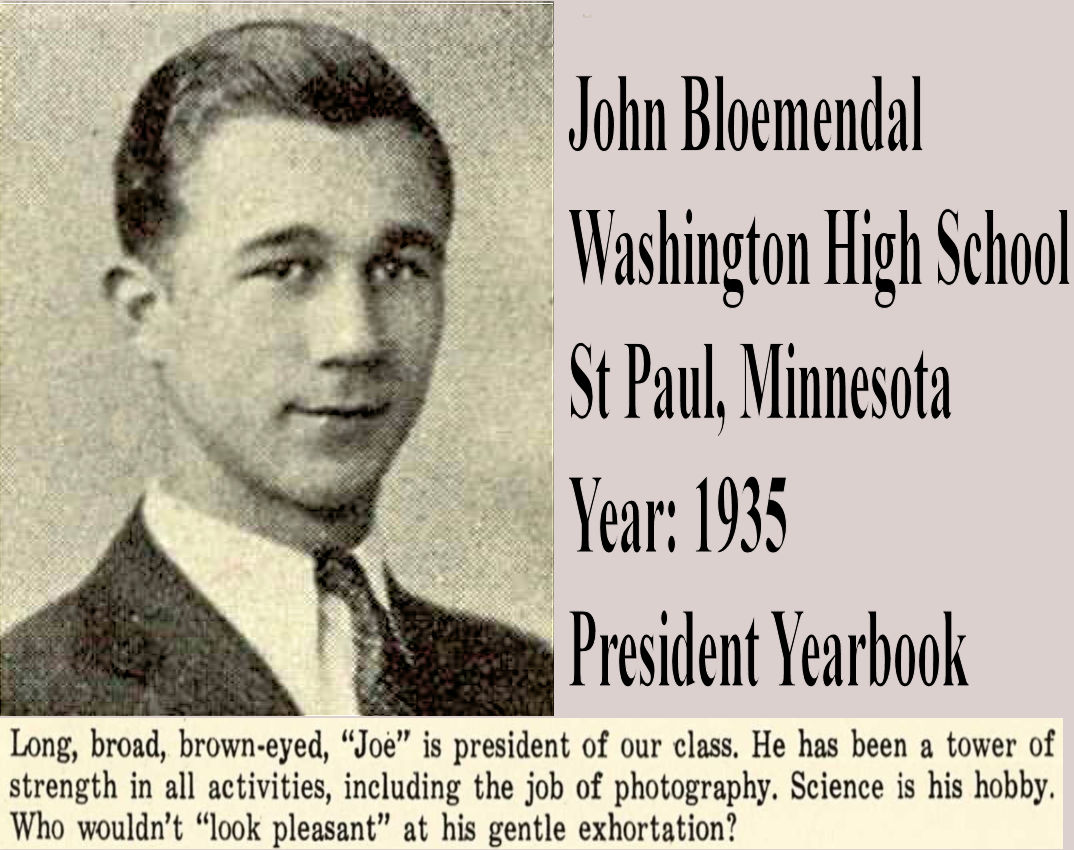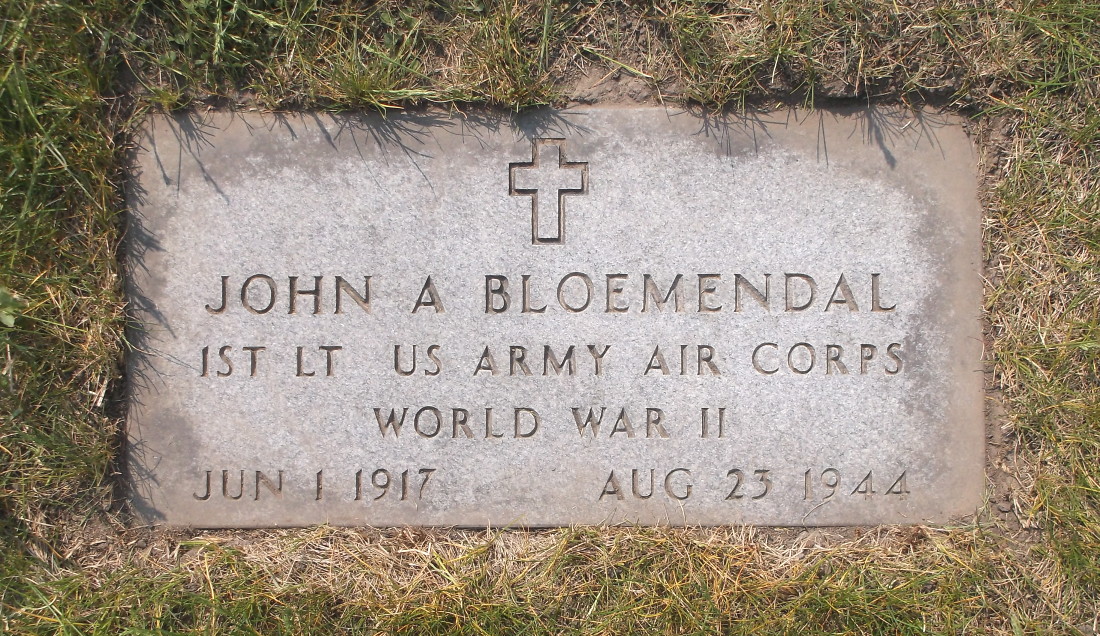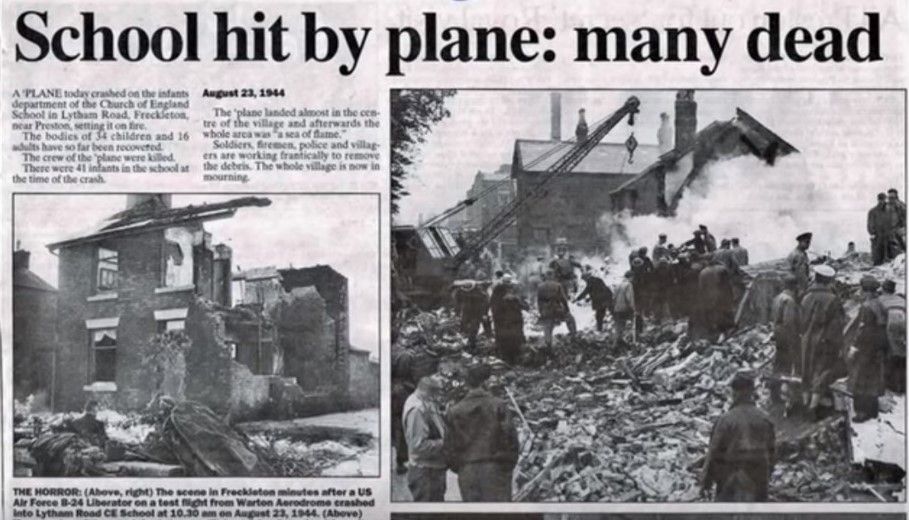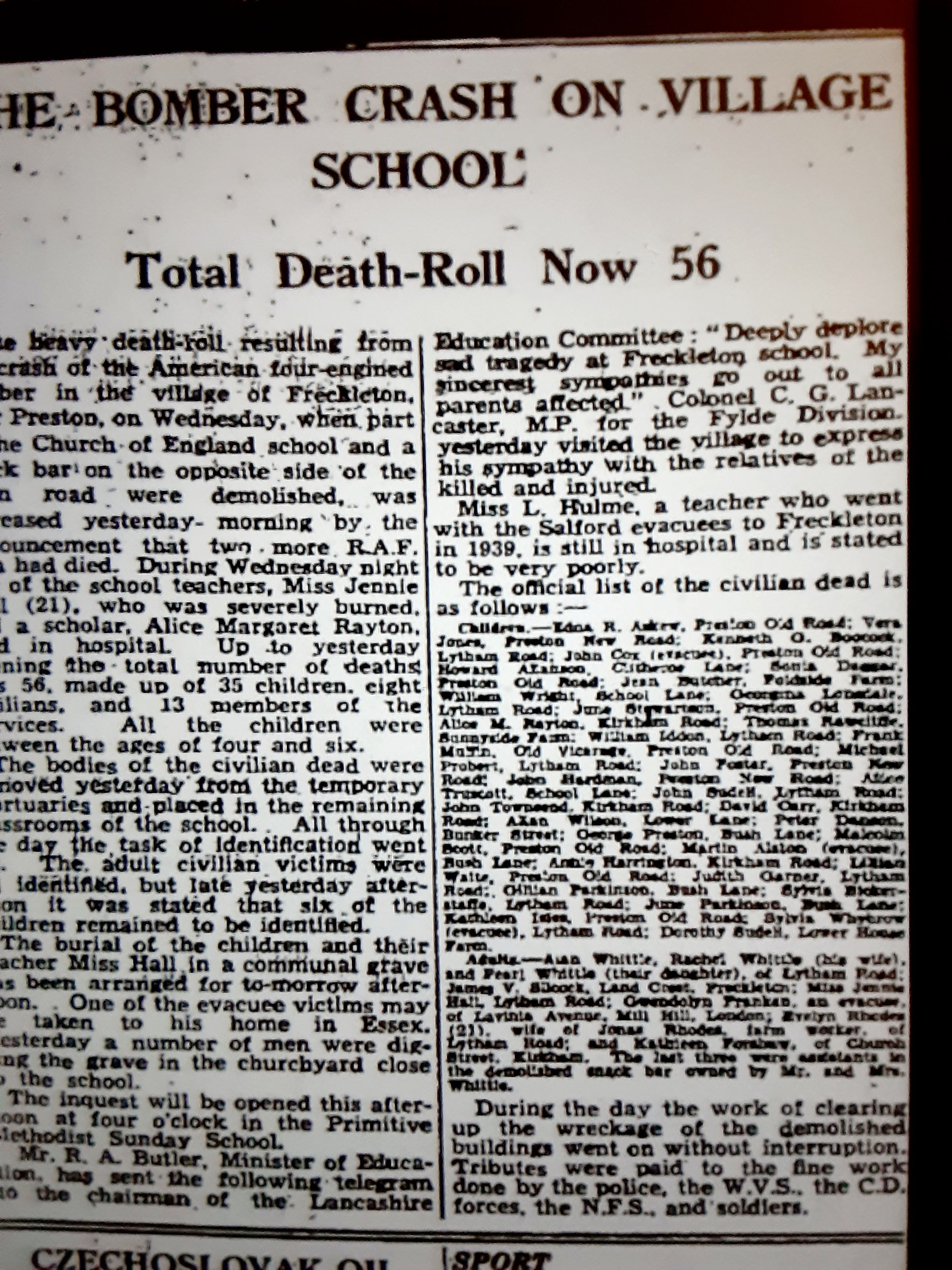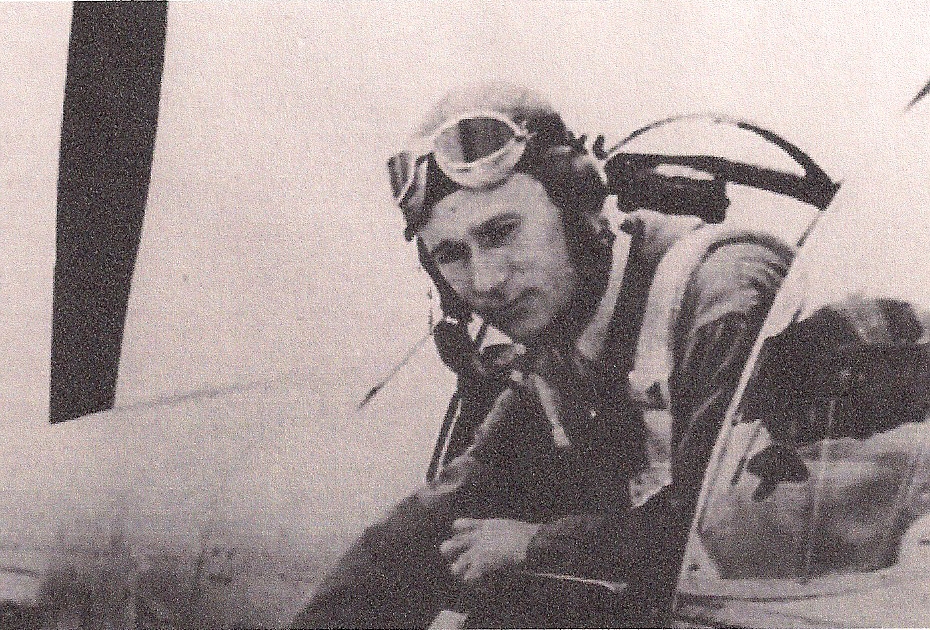UNITED STATES AIR FORCE
LIEUTENANT
Killed In Action
FRECKLETON DISASTER
UPDATE 19, FEBRUARY 2016: I'd like to note that different books, newspaper articles and even messages and letters from individuals trying to help me with my Freckleton pages each seem to have a different spelling of Mr. Bloemendal/Bloemendahl's name. I keep correcting my pages but have decided to leave John's page as is for now - after correcting the official name space with the most common spelling (and it is the spelling on the noted acknowledgement of death/burial info), the reader may find it spelled with the 'h' on some of the Freckleton pages in description of the plane crash. I think leaving it as such may help anybody else with the same spelling confusion - for instance, when I googled Mr. Bloemendal's FG page just now, the first spelling headlined links, but there were also strip links with the other spelling listed. My opinion is that if the confusion might help researchers find this page, then we should leave both choices up. =)
Enlisted in the U.S. Air Force March, 1942
Clocked over 740 flight hours testing airflight
1st Lieutenant John A. Bloemendahl was the American test pilot at the controls of a B-24 U.S. Liberator when, on 23, August 1944, the aircraft crashed during a thunderstorm into the small village of Freckleton. 61 people, including the pilot, would die, among them 38 children from the Freckleton Holy Trinity School.
I have tried to research this gentleman and am not getting very far, and would appreciate any comments or information site members might have; the photo used is public domain, and I have no connection to Lieutenant Bloemendahl's family or friends. I do, however, feel that he should have a page up on this site, with details of the crash and what led up to it.
Lieutenant Bloemendahl was already in air, as was another U.S. Liberator, when both crafts were called to ground due to oncoming inclement weather. What seemed to be a 'shower' at first had quickly uescalated to the sudden kind of thunderstorm that England is so well known for; by the time Bloemendahl was told to 'turn around', however, flash flooding was already being reported, and waterspouts were being reported in the Ribble Estuary.
Bloemendahl had been cleared to land when he radioed that he was aborting landing at the last moment, and that he would
'come round again'. There have been conflicting opinions of whether the Lieutenant's plane was then struck by lightning or if he just lost altitude and speed to the point that he could not correct, but the end result was that, when the pilot of the other plane radioed him mere minutes later, there was no reply.
Witnesses stated that the Liberator was just above the treetops when it appeared to have its' wings almost vertical; it then sheared through the tree tops and clipped the side and corner of a building. One wing came off at this point, barreling along the ground and into foliage.
The 25 ton fuselage tore through three homes and the 'Sad Sack' Cafe, causing many of the ground fatalities; the fuselage then continued across the road and into the Freckleton Holy Trinity School, hitting directly in the infants' wing. 38 children, the majority of them under the age of 6, were killed.
The official decision regarding the crash was listed as unknown, but it was questioned whether lightning had struck the plane, or whether Lieutenant Bloemendal, an American pilot, may have been unprepared for the intensity of the sudden storm. To my knowledge, these are the two most quoted opinions as to what triggered the horrible tragedy that day.
While Lieutenant Bloemendahl does seem difficult to 'track down', as noted at the beginning of this biography, I do feel that there is enough information on him to warrant a page, and again, I strongly feel that he should not go down in history as the guilty party in this event. I feel that the gentleman did all he could do that day, and this is verified in that he was being cautious to the point of radioing in that he was not happy with landing prospects and would be 'coming around again'.
Victims of this disaster, including Lieutenant Bloemendahl and his crew members, are listed on the Freckleton Disaster Web Page, as well as additional photos and information being available there. I have reprinted only the public domain photograph.
Lieutenant Bloemendahl's age, home state, marital status and other information would be greatly appreciated, to update this page. Thank You!
★★★★★★★★★★★★★★★★★★★★★★★★★★★★
"These heroes are dead. They died for liberty - they died for us. They are at rest. They may or may not sleep in the land they made free, under the flag they rendered stainless, under the solemn pines, the sad hemlocks, the tearful willows, and the embracing vines. They sleep beneath the shadows of the clouds, careless alike of sunshine or of storm, each in the windowless Place of Rest. Earth may run red with other wars - they are at peace. In the midst of battle, in the roar of conflict, they found the serenity of death. I have one sentiment for soldiers living and dead: cheers for the living; tears for the dead." ~Robert G. Ingersoll
UNITED STATES AIR FORCE
LIEUTENANT
Killed In Action
FRECKLETON DISASTER
UPDATE 19, FEBRUARY 2016: I'd like to note that different books, newspaper articles and even messages and letters from individuals trying to help me with my Freckleton pages each seem to have a different spelling of Mr. Bloemendal/Bloemendahl's name. I keep correcting my pages but have decided to leave John's page as is for now - after correcting the official name space with the most common spelling (and it is the spelling on the noted acknowledgement of death/burial info), the reader may find it spelled with the 'h' on some of the Freckleton pages in description of the plane crash. I think leaving it as such may help anybody else with the same spelling confusion - for instance, when I googled Mr. Bloemendal's FG page just now, the first spelling headlined links, but there were also strip links with the other spelling listed. My opinion is that if the confusion might help researchers find this page, then we should leave both choices up. =)
Enlisted in the U.S. Air Force March, 1942
Clocked over 740 flight hours testing airflight
1st Lieutenant John A. Bloemendahl was the American test pilot at the controls of a B-24 U.S. Liberator when, on 23, August 1944, the aircraft crashed during a thunderstorm into the small village of Freckleton. 61 people, including the pilot, would die, among them 38 children from the Freckleton Holy Trinity School.
I have tried to research this gentleman and am not getting very far, and would appreciate any comments or information site members might have; the photo used is public domain, and I have no connection to Lieutenant Bloemendahl's family or friends. I do, however, feel that he should have a page up on this site, with details of the crash and what led up to it.
Lieutenant Bloemendahl was already in air, as was another U.S. Liberator, when both crafts were called to ground due to oncoming inclement weather. What seemed to be a 'shower' at first had quickly uescalated to the sudden kind of thunderstorm that England is so well known for; by the time Bloemendahl was told to 'turn around', however, flash flooding was already being reported, and waterspouts were being reported in the Ribble Estuary.
Bloemendahl had been cleared to land when he radioed that he was aborting landing at the last moment, and that he would
'come round again'. There have been conflicting opinions of whether the Lieutenant's plane was then struck by lightning or if he just lost altitude and speed to the point that he could not correct, but the end result was that, when the pilot of the other plane radioed him mere minutes later, there was no reply.
Witnesses stated that the Liberator was just above the treetops when it appeared to have its' wings almost vertical; it then sheared through the tree tops and clipped the side and corner of a building. One wing came off at this point, barreling along the ground and into foliage.
The 25 ton fuselage tore through three homes and the 'Sad Sack' Cafe, causing many of the ground fatalities; the fuselage then continued across the road and into the Freckleton Holy Trinity School, hitting directly in the infants' wing. 38 children, the majority of them under the age of 6, were killed.
The official decision regarding the crash was listed as unknown, but it was questioned whether lightning had struck the plane, or whether Lieutenant Bloemendal, an American pilot, may have been unprepared for the intensity of the sudden storm. To my knowledge, these are the two most quoted opinions as to what triggered the horrible tragedy that day.
While Lieutenant Bloemendahl does seem difficult to 'track down', as noted at the beginning of this biography, I do feel that there is enough information on him to warrant a page, and again, I strongly feel that he should not go down in history as the guilty party in this event. I feel that the gentleman did all he could do that day, and this is verified in that he was being cautious to the point of radioing in that he was not happy with landing prospects and would be 'coming around again'.
Victims of this disaster, including Lieutenant Bloemendahl and his crew members, are listed on the Freckleton Disaster Web Page, as well as additional photos and information being available there. I have reprinted only the public domain photograph.
Lieutenant Bloemendahl's age, home state, marital status and other information would be greatly appreciated, to update this page. Thank You!
★★★★★★★★★★★★★★★★★★★★★★★★★★★★
"These heroes are dead. They died for liberty - they died for us. They are at rest. They may or may not sleep in the land they made free, under the flag they rendered stainless, under the solemn pines, the sad hemlocks, the tearful willows, and the embracing vines. They sleep beneath the shadows of the clouds, careless alike of sunshine or of storm, each in the windowless Place of Rest. Earth may run red with other wars - they are at peace. In the midst of battle, in the roar of conflict, they found the serenity of death. I have one sentiment for soldiers living and dead: cheers for the living; tears for the dead." ~Robert G. Ingersoll





